Peter Wright and John Peat of the B17 Steam Locomotive Trust outline the story behind new-build No. 61673 Spirit of Sandringham, reflecting on the past as well as the future of the LNER-designed 4-6-0.
Established in 2011 as an organisation with charitable trust status, the B17 Steam Locomotive Trust is building a full-size working example of an LNER B17 express passenger locomotive for use on the main line network and heritage railways.
The locomotive is to be known as No. 61673 Spirit of Sandringham by permission of the Queen’s estate.
Enjoy more Heritage Railway reading in the four-weekly magazine.
Click here to subscribe & save.
In addition to its prime objective of building a new example of a popular bnut extinct class, the B17 SLT is undertaking to maintain and develop traditional engineering skills in the British Isles wherever possible by engaging UK firms to manufacture the locomotive and to provide education and skills training for people in apprenticeships and other schemes associated with engineering, science and technology.
The newly-formed LNER soon realised that train weights and speeds of express passenger services in East Anglia were becoming beyond the capacity of the existing fleet locomotives.

Neither stopgap delivery of new engines of existing former GER designs, ‘Clauds’ and 1500s, nor the transfer of former GNR ‘Ragtimer’ 2-6-0s was sufficient to meet demand.
A new, more powerful locomotive was required. Constraints within which any new locomotives must conform included weight and length because of weak bridges and short turntables at the principal termini. These were overcome by having a three-cylinder design and using a GER-style short wheelbase tender.
The North British Locomotive Company of Glasgow was contracted to detail and build the locomotives within the parameters of the Gresley design.
Although the Gresley conjugated valve motion was incorporated, the mechanism was behind the cylinders – unlike Gresley’s Pacifics and three-cylinder 2-6-0s and 2-8-0s.

The thickness of the frames was also pared down to a minimum to save weight and due to the constraints of the shorter wheelbase, the middle cylinder drove the front driving axle, with the outside cylinders driving on the middle coupled axle. The resulting locomotive was the only new 4-6-0 class introduced during Gresley’s tenure of office.
On February 17, 1928 an order was placed with NBL for 10 locomotives to be supplied before the end of the year at a contract price of £7,280 each. All 10 were delivered on time to the LNER’s Eastfield depot, Glasgow, where they were given running trials. Records show No. 2807 Blickling made appearances at Edinburgh and Dundee – and even Aberdeen before all were sent south to English sheds.
A newspaper report of January 11, 1929 confirmed that King George V had given permission for No. 2800 to be named Sandringham after the monarch’s Norfolk country home. The naming scheme for the other locomotives reflected their use in East Anglia. For all their lives, these 4-6-0s would be known affectionately as ‘Sandringhams’.
Read more and view more images in Issue 250 of HR – on sale now!
Advert
 Enjoy more Heritage Railway reading in the four-weekly magazine. Click here to subscribe.
Enjoy more Heritage Railway reading in the four-weekly magazine. Click here to subscribe.











